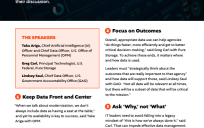Post Highlights
- Overview of 5 questions to ask for an analytics initiative
- Post provides steps to think through for analytics initiatives
- Analytics continues to transform the way government delivers services.
Undoubtedly, analytics is transforming the way government operates and delivers services to customers. At all levels of government, agencies are now challenged to reduce costs, improve efficiency, and implement innovative measures to meet the complex needs of an agency. Yet, government analytics still continues to mystify and challenge the public sector, as agencies are pressed to understand the value and leverage the opportunity which analytics presents.
Whether it is challenges to leadership, identifying value, or understand costs, agencies today are exploring how to understand how to truly leverage the power of analytics. As many government websites are becoming increasingly transactional and services move to self-service platforms, it’s becoming clear that with the volume of data that government collects, creates, stores and manages, can be used to transform how services are delivered. For government leaders looking to implement an analytics program, five basic questions come to mind to assist in the decision making process:
– Do employees have access to the right information?
– What problem are is trying to be solved? Or what service is needs improvement?
– How do agencies connect the dots and access other data?
– What new value has been created for customers? What’s the ROI?
– How do we show leadership and change culture with data?
Although these questions are important, one of the first steps to unlocking the power of analytics is basic data discovery to know what format data is, how to access data, verifying authenticity and beginning to baseline information. As data can be structured (relational database), semi-structured (think XML and email ) and unstructured (not predefined, doesn’t fit well into relational databases), it is important to know and learn what kind of format data is in, to start to unlock the power of analytics.
Clearly, there are dozens of questions an IT manager can ask, and GovLoop would love to learn some more of your insights to data analytics in our upcoming report. Be sure to take our survey and help us create a community based resource to help your peers address core challenges with government analytics, and how to fully leverage the volume of data agencies currently have.
Do we have access to the right information?
Understanding where data rests, the format of the data and who has access is essential to any analytics initiative. Once the decision is made to invest in an analytics strategy, agencies must locate and be sure they are actually collecting the right data to solve an organizational problem. For instance, if an agency is going to start recruiting employees due to members of the workforce retiring, agencies need to locate data that shows them retirement trends, expected retirement dates, and the start to craft their strategy around available information, or survey and collect the right information.
What problem are we trying to solve? Or what service are we trying to fix?
With the large volume of data that is created and stored, agencies must take a laser-like focus to solving problems with data use. If the end goal is to increase self-service through a new online portal, goals and metrics should be defined that clearly map to the over arching goal.
How do we connect the dots and access other data?
Once data is collected, stored and understood, it is important that information is shared, securely and safely. If information is confidential or sensitive information, then this information likely should not be shared. But, if information is not very confidential, like web information or page visits, then information should be shared to peers to help them see impact of any program they are running.
What new value has been created for customers? What’s the ROI?
A great case study of using customer insights and data to improve government services comes from the City of Santa Cruz. Emily Jarvis, GovLoop’s Online Producer shared the story on the DorobekINSIDER, you can check out the story by following the links below, Emily writes:
The City of Santa Cruz is the smallest community to ever partner with Code for America, but it had one of the largest problems to solve: how to make it easier to take an idea for a small business from conception to reality.
They created an online permitting portal OpenCounter. The portal launched last Wednesday January 9, after an intense year of development, testing, and refinement.
This question is also particularly important, because it will indicate how data has improved a service. With clear metrics set, and a thorough analysis of data, agencies can calculate their return on investment for analytics.
How do we show leadership and change culture with data?
Recently GovLoop’s Research Fellow, Kate Long, wrote a great post identifying that leadership as a missing piece to analytics. Be sure to check out her post, as she does a great job outlining some of the challenges to leadership and analytics. For those leading government analytics programs, it is essential to continue to craft a culture of openness, placing a strong emphasis on program effectiveness, supporting employees needs for technology and leading by example.
Starting, implementing, reforming or ending a program in government is no easy task, but the right decision can be made by sound data analysis. As government continues to develop more data and becomes increasingly complex, analytics is going to play an essential role in transforming how government operates.
What would you recommend to your peers? How can they get started with analytics? What questions should they be asking?




Leave a Reply
You must be logged in to post a comment.